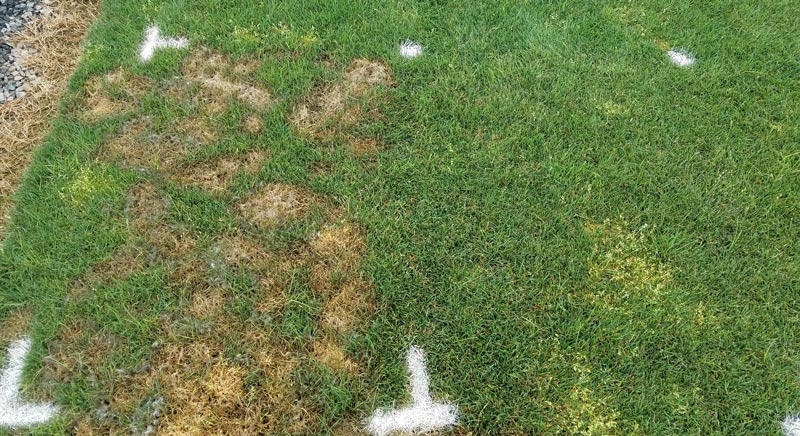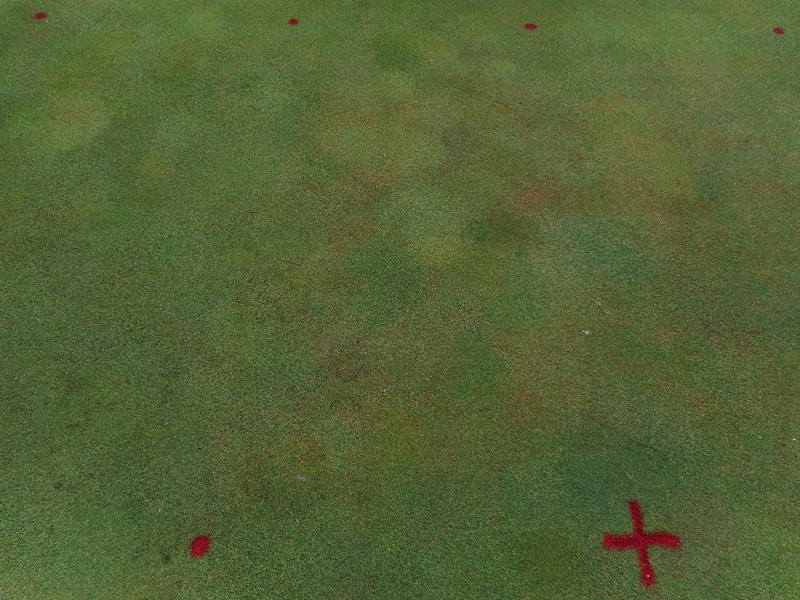
Pythium damping-off can impact seedlings of any turfgrass species. It begins in limited spots but can spread quickly. Photos courtesy of PBI-Gordon
Editor’s note: The following article was supplied by PBI-Gordon. All product claims, research cited and other information is directly from the company.
It’s that time of year again: The warm weather is here. We love it. Golfers love it. And unfortunately, Pythium loves it. An effective Pythium management program is vital to protecting your turf. The first step of that program: Identify the disease.
There are four main types of Pythium disease: Pythium root dysfunction, Pythium blight, Pythium damping-off and Pythium root rot.
Pythium root dysfunction
Pythium root dysfunction causes a significant reduction in roots’ ability to absorb nutrients and water from the soil. Infected roots are darker in color and lack the presence of root hairs, and the disease can cause discoloration, thinning and death of some plants.
- Found on bentgrass greens less than 10 years old, usually with sand-based root zones.
- Most common in the Southeast and the transition zone.
- Infection occurs when soil temperatures are between 50 degrees and 75 degrees F.
Pythium blight
Pythium blight impacts leaves and crowns, first appearing as circular patches of collapsed leaves and stems in small, sunken pockets of infected turf about 6 inches in diameter. Pythium blight spreads quickly, especially during rainy or humid periods any time of year.

Pythium blight
- Most damaging to perennial ryegrass, creeping bentgrass, Poa annua and fescues.
- Cottony, aerial mycelium is often visible.
- In cool-season turfgrass, infection occurs when daytime temperatures are greater than 85 degrees F; nighttime temperatures are greater than 65 degrees F; and relative humidity is greater than 90% for 14 hours.
- In warm-season turfgrass, infection occurs under rainy conditions when temperatures are greater than 50 degrees F.
Pythium damping-off
Pythium damping-off impacts turf seedlings, first appearing similar to seedling wilt, then causing further decline, with seedlings turning dark and eventually dying off.
- Develops both before and after seedling emergence, any time of year.
- Usually caused by Pythium pathogens but can also be caused by other fungal species.
- Starts in limited spots but can spread rapidly.
Pythium root rot
Pythium root rot symptoms include irregular patterns of orange or yellow turf, and the individual plants appear dark and greasy. Pythium root rot symptoms slowly develop as temperatures increase and when rainfall is adequate.

Pythium root rot
- Develops on poorly drained greens, especially creeping bentgrass and annual bluegrass.
- Infection occurs in spring/early summer. Symptoms are typically seen in summer months after heavy rainfall and hot weather.
- May occur anytime soil is waterlogged for extended periods.
Cultural practices and chemical control
In addition to correct identification, proper cultural practices are an important part of controlling Pythium diseases — and of growing strong, healthy turf in general. Those practices can include:
- Watering thoroughly, but avoiding overwatering.
- Improving light penetration and air circulation.
- Avoiding overfertilization with nitrogen.
- Improving drainage where necessary.
- Following a fungicide resistance management program.
Finally, you need to pick the right fungicide to control Pythium diseases. Segway Fungicide SC from PBI-Gordon gets them all. Segway controls Pythium root dysfunction, Pythium blight, Pythium damping-off and Pythium root rot.
The active ingredient in Segway, cyazofamid, features a novel mode of action that stops spores from germinating, inhibiting all stages of Pythium fungal development. This mode of action puts Segway in Fungicide Resistance Action Committee (FRAC) Group 21.
Segway can be applied two times consecutively up to three times per year at the highest labeled rate, and six times per year at the lowest rate. That application flexibility plus the fact that Segway has no known cross-resistance with other classes of fungicides make it excellent for resistance management programs.
Segway is labeled for use on golf course tees, fairways, roughs and greens, on professionally managed sports fields, on sod and seed farms, and by professional applicators on residential lawns. Learn more about Segway here. Always read and follow label directions.
It’s our favorite time of year. Don’t let Pythium ruin it — and your turf. Identify the disease and take control with best management practices and Segway.